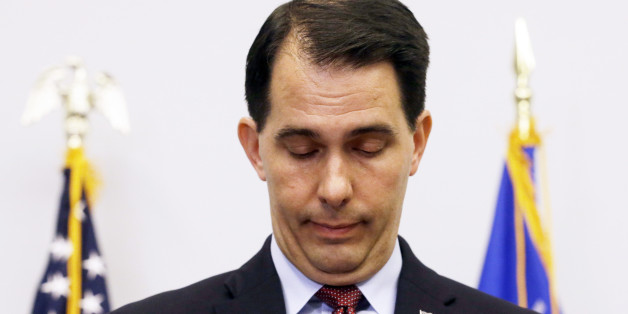THE BLOG
Illegal Dark Money In Wisconsin
10/06/2016 03:44 pm ET
Jay Mandle Professor of Economics, Colgate University

ASSOCIATED PRESS
On September 14th, The Guardian newspaper published 1,500 leaked documents collected by the Wisconsin prosecutors who were investigating suspected campaign violations by Scott Walker, the state’s Governor. The Guardian analysis found that these documents “speak to the cozy relationship between politicians and big business, and to the frustration of millions of Americans who feel disenfranchised by an electoral system that put (sic) the needs of corporate donors before ordinary Americans.”
The documents show how individual billionaires came to the rescue of the right-wing, anti-union Governor of Wisconsin when he was threatened with defeat in a recall election. They reveal that the Walker campaign solicited “dark money” donations from rich supporters, money that was directed to 501(c)(4) organizations, the most important of which was the Wisconsin Club for Growth. The Club for Growth then used the money to fight the recall campaign. As Walker’s top fundraiser put it in a leaked email, it was important that all the ads on his behalf “run thru one group to ensure correct messaging.”
By coordinating this effort, the Walker campaign broke the law. 501(c)(4) organizations like the Club for Growth are designated as social welfare organizations. They are able to take unlimited donations - Sheldon Adelson, for example contributed $200,000 to the Walker effort, while John Menard and Stephen Cohen each gave $1 million. But such organizations are prohibited from coordinating their activities in any way with campaigns. When Scott Walker and his fundraising team explicitly directed his donors to give to these organizations to help him fight the recall, they were engaged in a brazen violation of campaign finance laws. Indeed, a campaign consultant reported that the Wisconsin Club for Growth alone “raised 12 million dollars and ran a soup to nuts campaign...Polling, focus groups and message development was a collaborative effort.”
What makes this case all the more outrageous is that it was thrown out of court by Wisconsin Supreme Court justices who themselves had demonstrable conflicts of interest. For example, one judge was the recipient of $1.5 million for his own judicial race from the same Wisconsin Club for Growth.
An appeal to this verdict is now before the United States Supreme Court. But no matter how that ruling comes down, there are three lessons that the campaign finance reform community should learn from The Guardian’s expose.
The first is that many rich political campaign donors do not believe that rules and laws apply to themselves. Convinced of the legitimacy of the privileges that come with their mega-billions, they feel free to disregard legal restrictions in the name of their self-interested politics. They skirt the law by having their lawyers and accountants find loopholes. But when that is not possible, they will, as in the Walker this case, simply disregard any limitations.
The second is that the power of wealth shapes the course of history. If Walker had been recalled, Wisconsin would have been set on an altogether different path than the anti-labor agenda promulgated by the Governor. Limiting the political power of wealth is not simply a “good government” issue, though it is that. It is a tool to democratize politics. With reform the policies that are adopted by legislatures would serve the interests of more than the handful of individuals who now underwrite the political process.
The third lesson is the most difficult one. Laws and rules restricting donor contributions will not adequately curb the political power of wealth. The only way to do so is with public taxpayer money funding campaigns, and it will take a lot of it to be successful. Candidates and the political process itself must be freed from having to depend on wealthy funders.
It is true that both Hillary Clinton and Bernie Sanders have endorsed the public funding of campaigns. But neither has addressed the level of funding they would support, or how the changes they seek will be paid for. As a result, reformers have not been adequately armed for the struggle that will ensue once transformation of the current system appears on the legislative agenda. Publicly funded candidates will not necessarily have to match the level of donations that their privately funded opponents receive. But they will require more than a bare-bones allocation to be competitive.
We live in an era when it is clear to all who care to look, that the political process has failed the American people. They in turn deeply distrust politicians. Yet the society has to be governed: politics is both necessary and inevitable. It important to establish that there is an alternative funding system that will serve the electorate better than the one we have. But that alternative will not be inexpensive.
The rich are prepared to invest a lot to defend their interests; the people of the country will have to be convinced to do the same.
Above is from: http://www.huffingtonpost.com/jay-mandle/illegal-dark-money-in-wis_b_12213770.html


